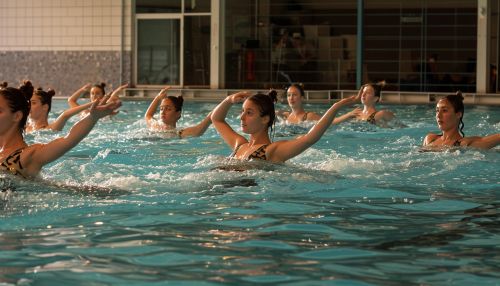Synchronized swimming at the Summer Olympics
History
Synchronized swimming, now known as artistic swimming, is a hybrid form of swimming, dance, and gymnastics, consisting of swimmers performing a synchronized routine of elaborate moves in the water, accompanied by music. The sport made its debut at the Summer Olympic Games in 1984, in Los Angeles, USA. Prior to this, it was part of the Olympic program as a demonstration sport in the 1952 and 1984 games.


Events
There are three events in synchronized swimming at the Summer Olympics: solo, duet, and team. The solo event was held only in 1984 and 1988. The duet event has been held at every Olympics since 1984, except for 1996. The team event has been held at every Olympics since 1996. Each event is scored by a panel of judges who evaluate the performance based on execution, artistic impression, and difficulty.
Scoring
In synchronized swimming, the scoring system is based on the execution, difficulty, and artistic impression of the routine. The execution score evaluates the technical skills of the swimmers, the difficulty score assesses the complexity of the movements and formations, and the artistic impression score rates the creativity, choreography, and synchronization of the routine. The scores from each judge are added together to give the final score.
Notable countries and athletes
Several countries have been particularly successful in synchronized swimming at the Summer Olympics. Russia has been the most successful, winning every gold medal in the team event since it was introduced in 1996, and all but one gold medal in the duet event since 2000. Other successful countries include the United States, Canada, and Japan.
Notable athletes in synchronized swimming include Natalia Ishchenko and Svetlana Romashina of Russia, who are among the most decorated synchronized swimmers in Olympic history. Other notable athletes include Americans Tracie Ruiz and Sarah Josephson, and Canadians Sylvie Fréchette and Carolyn Waldo.
Training and preparation
Training for synchronized swimming at the Olympic level requires a combination of swimming skills, strength, flexibility, and artistic ability. Swimmers typically train for several hours a day, focusing on improving their swimming technique, strength and conditioning, and choreographing and practicing their routines.
Future of the sport
The future of synchronized swimming at the Summer Olympics looks bright, with the sport continuing to grow in popularity and participation. The International Olympic Committee has shown support for the sport, with the recent name change to artistic swimming reflecting a desire to highlight the artistic and creative aspects of the sport.
